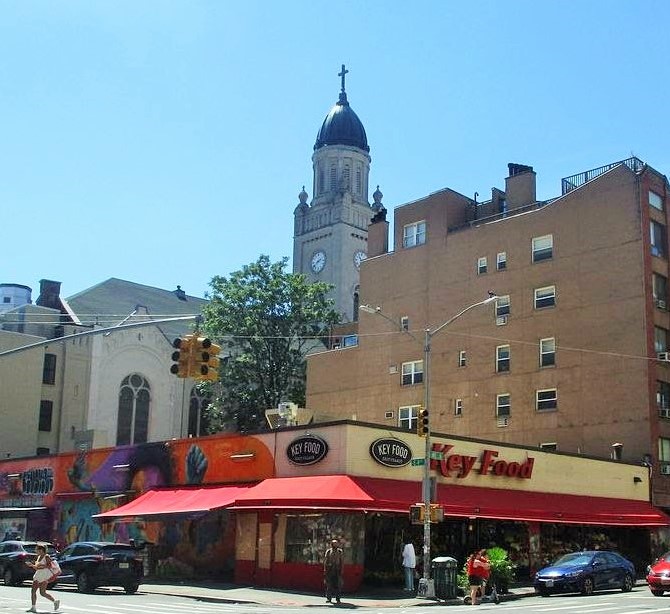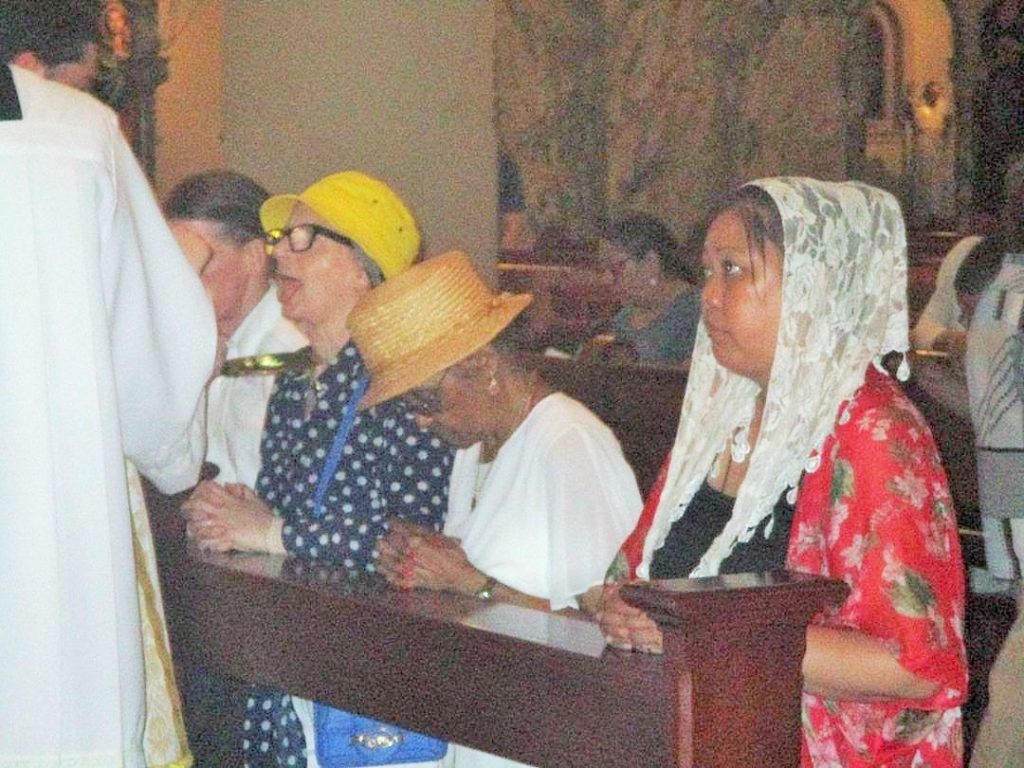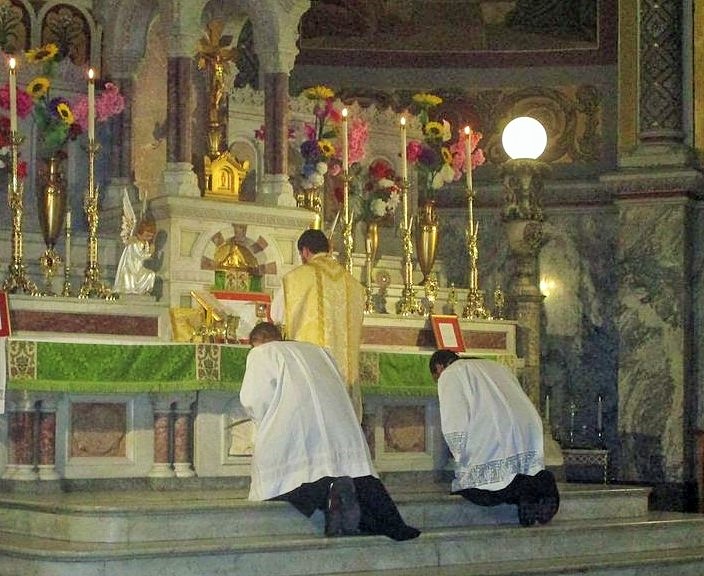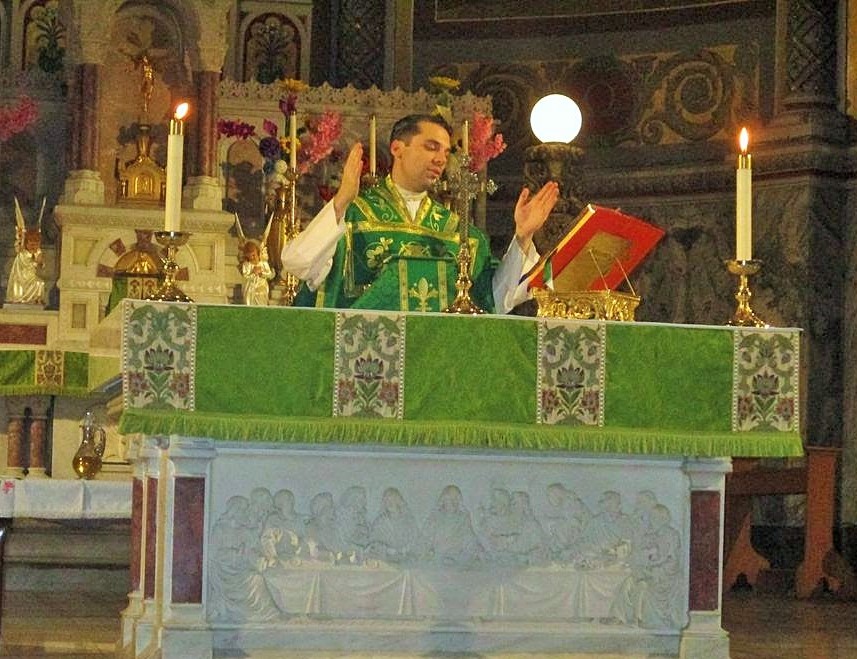BY MARY REINHOLZ | The Reverend Father Sean Connolly faced about 30 parishioners from behind a free-standing altar at the Church of the Most Holy Redeemer and Nativity. It was noon on a hot summer day as Connolly, resplendent in a green cassock, began celebrating a modern bilingual Mass in English and Spanish.
The Roman Catholic diocesan priest, 33, is pastor/administrator of the historic East Village church at 173 E. Third St.
The faithful joined him in prayers and in singing hymns like “Ave Maria,” several holding rosary beads. Connolly washed the feet of a disabled elderly woman in a front pew, moments before offering her a consecrated communion wafer.
Three days later, at noon on Aug. 6, the Reverend Father Alessandro da Luz, a visiting priest from the Long Island Diocese of Rockville Centre, celebrated the controversial Latin Mass at Holy Redeemer. It was one in a series of five Masses that will be conducted — for a second year — on the first Saturday of each month at the soaring baroque edifice in the East Village.
This ancient Mass drew about 150 people, many Latino. Da Luz stood at the high altar, facing the tabernacle as he murmured prayers in Latin. An altar server rang a communion bell when he elevated the host. A church choir sang in Latin, as well.

Da Luz, who also released incense, repeatedly called out to congregants, “Dominus Vobiscum” — meaning “The Lord is with you” in English — words from traditional Latin Masses that were codified from earlier liturgies by the Council of Trent (1545-1563) and used in the Roman Missal from 1570 up until the Second Vatican Council of 1963-65 (a.k.a. Vatican II), which ushered in new Masses in the vernacular.
Often called the Tridentine Mass or the “extraordinary form,” the Latin Mass has been threatened with total extinction ever since Vatican II, notably last summer when Pope Francis reversed a 2007 ruling from his still-living predecessor, Pope Benedict XVI, who had relaxed restrictions on the old rite, allowing it to flourish.
Francis, in an apostolic letter titled “Traditionis Custodes,” called on bishops around the world to reimpose restrictions on the Latin Mass in their parishes, claiming it had created division in the church spurred by people opposed to the reforms of Vatican II.
Traditional Catholics responded in fury: One conservative writer claimed Francis was “destroying” the church.
The new law requires celebrants of the Latin Mass to obtain signed permission from local bishops; to practice in nonparish churches; and to express fealty to the reforms in liturgy defined by Vatican II.
Connolly, who is on his first pastoral assignment at Holy Redeemer, said he obtained permission last year to celebrate the Latin Mass from the New York Archdiocese.
“I think the Latin Mass gives you a real sense of the sacred, and of the purpose of the Mass,” he said in a telephone conversation.

It’s still unclear whether he will be allowed to continue to offer the old rite after the current series concludes in December. The church bulletin doesn’t even describe the series as Latin Masses.
Cardinal Timothy M. Dolan, New York’s archbishop, is still evaluating his response to Francis’s letter from July 16, 2021, according to Joseph Zwilling, a spokesperson for the archdiocese.
“The matter is still under review and [Dolan] has not taken action as yet,” Zwilling told this reporter, adding, “The New York Archdiocese is happy to be in compliance with The Holy Father’s wishes and is studying the best way to do that before we issue any guidelines for this archdiocese.”
Zwilling noted that there were people with “passionate views” on both sides of the debate. Indeed, one skirmish in the so-called “worship wars” featured advocates for the “timeless” Mass booing liberal Chicago Cardinal Blase Cupich, who has banned the Latin rite from being said in parishes at Christmas, Easter and other other feast days.
Francis’s efforts to suppress the Latin Mass have caused “confusion” and distress at Holy Redeemer, said a parishioner in his 30s who identified himself only as Matthew, noting that the venerable rite has drawn younger Catholics of his generation.
Matthew was one of the altar servers at the Latin Mass conducted by Father da Luz at Holy Redeemer.
The bearded priest said, “I don’t know,” when asked why Francis was cracking down on Latin Masses. “I wish I knew,” da Luz added, noting Latin Masses are “well attended” in his Rockville Centre diocese, a Latin Mass ecclesiastical territory of the Catholic Church.
In contrast, Cardinal Wilton Gregory, the Washington, D.C., archbishop, last month banned the Latin Mass outright at Catholic parishes in compliance with Francis’s 2021 decree, allowing it to be celebrated only in three nonparish churches in his archdiocese starting on Sept. 22.

The New York Archdiocese could not provide a list of Roman Catholic parishes offering the Latin Mass in the city. It appears that only one, the Shrine and Parish Church of The Holy Innocents, at 128 W. 37th St., conducts Latin Masses exclusively, seven days a week. Its pastor, the Reverend Father James L.P. Miara, did not respond to an e-mail requesting additional information and was unavailable for comment.
A 24-year-old immigrant factory worker from Williamsburg, who called himself Red, said he regularly attended Latin Masses at Holy Innocents and enthusiastically praised the rite celebrated by Father da Luz at Holy Redeemer.
“It was inspiring, uplifting, bringing all that history back,” he said. “It was like going into another world, and to a Mass that the apostles celebrated.” He claimed Vatican II reforms had made some contemporary Catholic Masses more like “Protestant” worship.
Dorothy Day, the Christian anarchist and co-founder of the left-leaning Catholic Worker movement — who is now being considered for sainthood in Rome — reportedly loved the Latin Mass. So did many famous writers, intellectuals and scholars, Catholic and non-Catholic from the last century. Among them were famed British crime writer Dame Agatha Christie, who joined in petitioning the Holy See to keep the rite more than 50 years ago, saying it had inspired priceless works of art and literature.
The Reverend Father James Cascione is a former parochial vicar at Holy Redeemer and a member of the Redemptorist priests, a missionary order that founded the parish for German-speaking immigrants in 1841. He said he likes “both rituals” and finds it “difficult to understand” Pope Francis’s strict limits on the Latin rite. However, Cascione doesn’t believe Francis has “created division. That comes from the traditional people who are feeling alienated right now,” he said.
The 64-year-old priest, now living in a Pennsylvania Redemptorist care facility after suffering a stroke more than a year ago, also noted that Francis could have completely banned the Latin Mass, but didn’t.
“The pope could theoretically mandate and totally wipe out the Latin Mass, but popes usually don’t go that far,” he said. “[Francis] would get resistance from bishops who don’t like the Latin Mass but tolerate it. He could ban it, but it’s not worth the trouble.”


Also, the church of the MHR is also the official NYC Shrine and custodian of the miraculous antique icon (copy of the original) of Our Mother of Perpetual Help, so the “Latin Rite” mass celebrations were actually the special “Five First Saturday” devotions with a sung litany after, as requested by Our Lady of Fatima during her Vatican approved apparitions, in Portugal to the three saintly shepherd children in 1917, to obtain peace for the world, which the world desperately needs now and we also venerated the icon of Our Mother of Perpetual Help. These devotions are also performed in numerous Catholic churches around the world and they are permitted in either the Novo Ordus or the Latin Rite. The author also mentions about Bilingual English-Spanish masses? Yes, these are perfectly fine to perform as well and necessary! These are bilingual but they can’t also be in Latin, as the author mentions, as they are not “tri-lingual!” Another error is when the author calls the Holy Communion “consecrated communion wafers!” After the consecration by the priest, we believe it is the Body, Blood, Soul and Divinity…Jesus Christ Himself…that we are receiving, not “consecrated wafers or cookies!” That is disrespectful to write. So these were all the mistakes the author wrote, due to a lack of proper research on her part! Perhaps in the future, the author and editor of the Village Sun will hopefully do more research on the facts of their articles!
There are numerous errors by the writer of this article. Fr. Connolly did not “wash the feet of an elderly woman right before giving the communion!” Washing of the feet by a priest is only done during Holy Thursdays and the rite of the mass doesn’t matter, that is the practice in Novu Ordos masses as well annually! Pope Francis washes feet also, only during Holy Thursdays! This was never done during the Saturday 12:00 pm masses. The special series of 5 First Saturday masses and litany to the miraculous Our Lady of Perpetual Help Icon, as the Church of MHR, is the official shrine of this icon, was done at the request of Our Lady of Fatima during her apparitions to the three saintly shepherd children, to obtain peace for the world and they are known as the Five First Saturday Devotions! These were the mass and devotions celebrated at the church of the MHR, during First Saturdays only. Also, it is disrespectful to refer to Holy Communion as “concecrated communion wafers!”, as is written in this article. As Catholics, we believe that we are receiving the true Body and Blood of Our Lord Jesus Christ Himself! We are not receiving merely “consecrated communion wafers!” The Saturday Vigil and Sunday masses were always regular Nous Ordo masses and it is quite permissible to also sing Hymns and prayers in Latin during Novo Ordud masses. So, there were numerous errors written in this article by the author.
Were you present at the Latin Mass I reported on back in 2022? I doubt that you were and have to wonder why you’re accusing me of errors in reporting as if you were a witness to something I saw quite a while ago. You can be sure I will be in touch with Father Connolly regarding your allegation that he “did not wash the feet of an elderly woman.” All I can tell you now is that he never disputed my account in the Village Sun and one of his assistants at Most Holy Redeemer praised the article.
While I disagree with your claims about “numerous errors” in my 2022 story about the Latin Mass at Most Holy Redeemer in the East Village and your allegation that the phrase “consecrated communication wafers” was disrespectful, this writer was in error stating that The Rev. Father Sean Connolly “washed the feet” of a congregant during a bilingual Mass on a hot summer day. I thought that was what he did in bending over the congregant in front of me, seemingly at her feet, but I’ve since been informed that such a ritual only occurs on Holy Thursday.
The Mass was changed so that “the people” could more fully participate and “understand”, yet our churches, seminaries and convents are less full today than they were before the changes were made.
“Faith” does not require intellectual understanding, as good as that may be. Look at the countless saints and laypeople over the centuries who were uneducated, yet who believed and received the Body and Blood of Christ while hearing Latin and even praying or singing in it by rote.
The motto of St. Anselm was, “Credo ut intelligam”, meaning, “I believe in ORDER to understand.” All of the “understanding” in the world will not bring us one jot closer to God or salvation if faith/belief doesn’t come first, and those things were present when the old Mass was the norm.
I once worked in a parish where a priest one Sunday handed me a ciborium full of consecrated hosts after Mass, saying, “Put this away for me, will you?” while handing me the tabernacle key. I wasn’t a deacon, I was a layman. He spoke matter of factly, as if he was asking me to put away anything but the Body of Christ. At another church I found the altar stone from the old altar tossed into a cabinet with rags and metal polish. None of this happened when the Mass was treated as a sacred thing tied to tradition, not as a casual gathering with a social purpose.
The word “religion” means, “to rebind, to reconnect”. To what? To God, to each other, and to those who came BEFORE. We do the latter in part when we worship like they did.
Your not going to bring young people back to church with the Latin Mass. I’m finding less and less people attending mass on a weekly basis b/c either the priest preaches for 25 minutes or there is a language barrier. The Archdiocese of NY needs to do a better job and unfortunately Cardinal Dolan is probably not up to the Task as he is alienating more people
To: The Editor
Re: “Latin Mass celebrated in E.V. to pope’s chagrin” (news article, October):
Fathers Connolly and Da Luz are to be congratulated for their courage in saying the Mass in Latin, just as it was said for nearly 2,000 years before the Protestantization of the Roman Catholic Church began in the late 1960s. The decline in Catholic Church attendance and the gradual weakening of Catholic culture in America began with the unfortunate decisions spearheaded by John XXIII and Vatican II. With the entire world adhering to the Latin Mass, Catholics in Italy, Poland, France, Spain, America, Canada, Mexico, Brazil, Japan, Australia, Ghana, etc. engaged in a peculiar mystical unification. Since the change, the Church has become something of a Babel. Moreover, the jettisoning of the Latin Mass ended the gracious entry of all Catholics into the Latin language, the source of the Romance languages and the rich cultures of Italy, France, Spain, Portugal, Romania, Latin America and South America.
Alan Shuback
Fascinating story. I did not know Latin Masses still existed in New York City
Wow, to actually ban the Latin Mass seems a little harsh. I regularly go to Mass at Holy Redeemer and although the Latin Mass is longer, it is the sacred history of the Catholic Church. If priests want to say the Mass in Latin and if the parishioners want to participate, that should be enough. There is definitely a spiritual beauty to the Mass in Latin.
Wow, surprisingly well balanced! Nicely done. Hope you will develop a source material relationship with America magazine. Head office in Manhattan.
Good idea! Thank you.
The wonderful thing about the Latin Mass is that it’s the same everywhere. If you’re traveling in a foreign country you can understand what is going on and feel right at home. Where the Mass is said in modern languages it seems alien and you can’t even understand what is being said. Also, the Latin hymns are very beautiful.